
table of contents
- Green spots on the Hokkaido pumpkin
- Recognize the state of maturity
- Ripening pumpkins
- storage
Of the Hokkaido pumpkin (Curcurbita maxima 'Red Kuri') is an absolute classic in autumn. For several years it has been the most popular pumpkin variety in this country. Due to its size, the Hokkaido is also suitable for single households. The pumpkins are real all-rounders. They are rich in vitamins A and B, low in calories, therefore very healthy and also suitable for consumption by figure-conscious people. But sometimes green spots can be found on the skin and in the pulp of Hokkaido. What's it all about? Is the pumpkin still edible?
Green spots on the Hokkaido pumpkin
The pumpkins have their origin, as the name suggests, in Japan. There it is called Uchiki kuri and is also known as chestnut, onion or chestnut squash. The popular vegetable variety has high season in early and late autumn. The little one has many advantages:
- Weight 1 to 3 kg
- smaller than his relatives
- slightly sweet, nutty-mild taste, similar to chestnuts
- orange-colored, juicy and low-fiber pulp
- thin shell and kernels edible
- just wash it thoroughly
- quick and easy preparation
- Can be kept for up to a year
Sometimes you can at the stem, in the skin and pulp of the Hokkaido green spots to be available. This is usually not a cause for concern; the only thing is that the pumpkin is not yet fully ripe. These areas do not necessarily have to be cut out. The pumpkins are nevertheless edible. The discoloration is not harmful to health. However, such a Uchiki kuri does not have a long shelf life. It should be prepared promptly.

Note: Tomatoes and potatoes can also be discolored. However, caution is advised with these nightshade plants. Green spots are not edible here. They contain Solaninewhich leads to poisoning.
Recognize the state of maturity
The winter squash can be harvested between September and December. The fruit ripeness depends on the
- Time of sowing and
- Weather conditions during the growth phase
Only fully ripe fruits should be harvested. Depending on the variety, ripening takes place in a warm and dry place.
However, the state of maturity is difficult to see from the outside. A strong color between orange and red without green spots are external signs of the degree of ripeness. Further indications of an early harvest are
- woody stem
- must be brown and dried up
- Press in the stem with a fingernail, no juice escapes
- hollow, dull sound when knocking with knuckles
- plump shell
Note: In addition to the orange variety, there are also green and gray Hokkaido pumpkins. These are particularly popular in Japan. In this country, these varieties are more likely to be immature, which is not the case. The pulp is similar to that of the orange-red Hokkaido and is just as tasty.
Ripening pumpkins
Not all pumpkins on a plant are ripe at the same time. The plants can produce fruits of varying degrees of ripeness during harvest. Usually the pumpkins ripen first at the beginning of the shoots. A sure instinct is required here. In addition, the pumpkins cannot tolerate wet and cold weather. Usually they then start to rot. If damp and cool weather is forecast in October and the fruits are not yet fully ripe, it is advisable to put straw or styrofoam sheets under the fruits. This protects them from excessive moisture.
In addition, there is also the possibility of harvesting the pumpkins in the unripe state in autumn before the first frosts or longer periods of rain. A single night at temperatures below zero is enough and the pumpkin can no longer be used.
- Cut off above the stem base
- Leave at least 3 cm of the stem on the fruit
- Do not damage the stem and pumpkins
- Use a sharp knife or secateurs
- Dry moist pumpkins on newspaper for a few days
- bright storage
- 20 ° C necessary for subsequent ripening
Pumpkins usually ripen within two to three weeks. Your quality is retained. However, only pumpkins without external injuries should be allowed to ripen.
Note: To speed up the ripening process for pumpkins, they should not be watered in autumn. Furthermore, it makes sense to cut through all the roots with a sharp spade at a distance of half a meter around the plant.
storage
Hokkaido pumpkins that have ripened in the house can also be stored for a few months afterwards.
- store in a cool, dry place
- frost-free room necessary
- ideal basement or garage
- Temperature between 10 ° C and 15 ° C
- ventilate well
- Don't stack pumpkins
- Styrofoam or wooden board as a base
- also possible hanging in the net
- Do not remove and injure the stem
- regular controll
Undamaged, fully ripe pumpkins can be kept for between four and six months, sometimes up to a year. However, after about three months, the quality of the stored fruit decreases. Damaged fruits should therefore be processed quickly; freezing is also possible here.

Note: The shelf life of Hokkaido pumpkins varies from year to year. The decisive factor is the weather conditions during the harvest. Fruits that have been harvested after a long period of drought are particularly storable.


